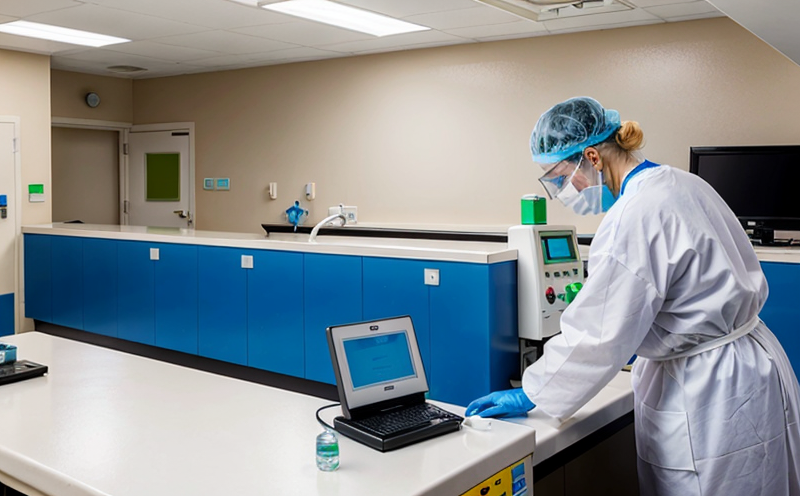Influenza Virus Surface Contamination Testing in Waiting Areas
The waiting areas of hospitals and healthcare facilities are often environments where the risk of viral contamination is particularly high. Influenza viruses, especially during flu season, can persist on surfaces for extended periods, posing a significant threat to patients, visitors, and staff alike. Conducting regular surface contamination testing in these areas is essential for maintaining hygiene standards and ensuring patient safety.
The influenza virus, scientifically known as Influenzavirus A, belongs to the family Orthomyxoviridae. It can survive on various surfaces such as plastic, metal, and glass for up to 48 hours under optimal conditions. Testing these surfaces helps healthcare facilities identify potential hotspots of contamination and implement targeted cleaning protocols.
Our testing service uses advanced molecular detection techniques based on ISO standards to detect the presence of influenza virus RNA on surfaces. This non-destructive approach allows for accurate identification without compromising the integrity of the surface material. The test is performed using a swab sample collected from high-touch areas such as handrails, doorknobs, and seating.
The testing process involves several key steps:
- Sampling: A sterile cotton-tipped swab is used to collect samples from designated surfaces.
- Transportation: Samples are placed in a viral transport medium and transported to our laboratory for analysis.
- Extraction: Viral RNA is extracted using a column-based extraction method.
- Detection: Real-time RT-qPCR (Reverse Transcription Quantitative Polymerase Chain Reaction) is used to detect the presence of influenza virus RNA. This method allows us to quantify the viral load if present.
The results are typically available within 24-72 hours, depending on the urgency and volume of requests. Our laboratory adheres strictly to ISO 15189 standards for quality management in medical laboratories, ensuring reliable and accurate test results.
Understanding the importance of surface contamination testing is crucial in preventing the spread of infectious diseases like influenza. Regular monitoring can help facilities implement effective cleaning protocols, thereby reducing the risk of transmission within the healthcare setting. This proactive approach not only protects patients but also supports broader public health initiatives aimed at minimizing viral outbreaks.
Benefits
The benefits of conducting influenza virus surface contamination testing in waiting areas are numerous and far-reaching:
- Improved Patient Safety: By identifying contaminated surfaces early, facilities can take immediate action to disinfect them, reducing the risk of viral transmission.
- Enhanced Compliance: Regular testing ensures that facilities meet regulatory standards for hygiene and infection control. This is particularly important in healthcare settings where compliance with guidelines such as those set by the World Health Organization (WHO) and Centers for Disease Control and Prevention (CDC) is mandatory.
- Data-Driven Decisions: The results of these tests provide actionable data that can be used to refine cleaning protocols, optimize resource allocation, and improve overall facility hygiene.
- Increased Efficiency: Early detection allows for targeted interventions, reducing the need for extensive and costly deep-cleaning procedures. This approach is more efficient in terms of both time and resources.
In addition to these tangible benefits, regular testing fosters a culture of cleanliness and accountability within healthcare facilities. It also enhances public trust by demonstrating a commitment to patient safety and well-being.
Why Choose This Test
There are several compelling reasons why healthcare facilities should prioritize influenza virus surface contamination testing:
- Expertise: Our team of experts has extensive experience in conducting high-quality, accurate tests. We use state-of-the-art equipment and adhere to strict quality control measures.
- Rapid Turnaround Time: With results typically available within 24-72 hours, our service ensures that facilities can act promptly on test findings.
- Comprehensive Reporting: We provide detailed reports that include not only the presence or absence of influenza virus RNA but also actionable insights for improvement.
- Cost-Effective: While testing may seem costly at first glance, the long-term benefits in terms of reduced infections and improved patient outcomes make it a worthwhile investment.
Moreover, choosing our service means that you are partnering with a facility that is dedicated to continuous improvement. We work closely with clients to understand their unique needs and tailor our services accordingly. This collaborative approach ensures that the testing process aligns perfectly with your organizational goals.
Environmental and Sustainability Contributions
In addition to its immediate health benefits, influenza virus surface contamination testing plays a significant role in promoting environmental sustainability:
- Reduced Use of Antibiotics: By preventing the spread of infections, this testing helps reduce unnecessary antibiotic usage. Excessive use of antibiotics contributes to the rise of antibiotic-resistant strains, which is a major global health concern.
- Minimized Waste Generation: Targeted cleaning protocols based on test results minimize the need for extensive and potentially wasteful cleaning procedures. This approach supports waste reduction efforts within healthcare facilities.
- Energy Efficiency: Efficient cleaning practices can lead to reduced energy consumption, as targeted interventions are more efficient than broad-based cleaning campaigns.
The commitment to environmental sustainability is a core value at our laboratory. By integrating testing into broader hygiene and infection control strategies, we contribute to the overall goal of creating healthier environments both for patients and staff while also reducing the ecological footprint of healthcare facilities.





